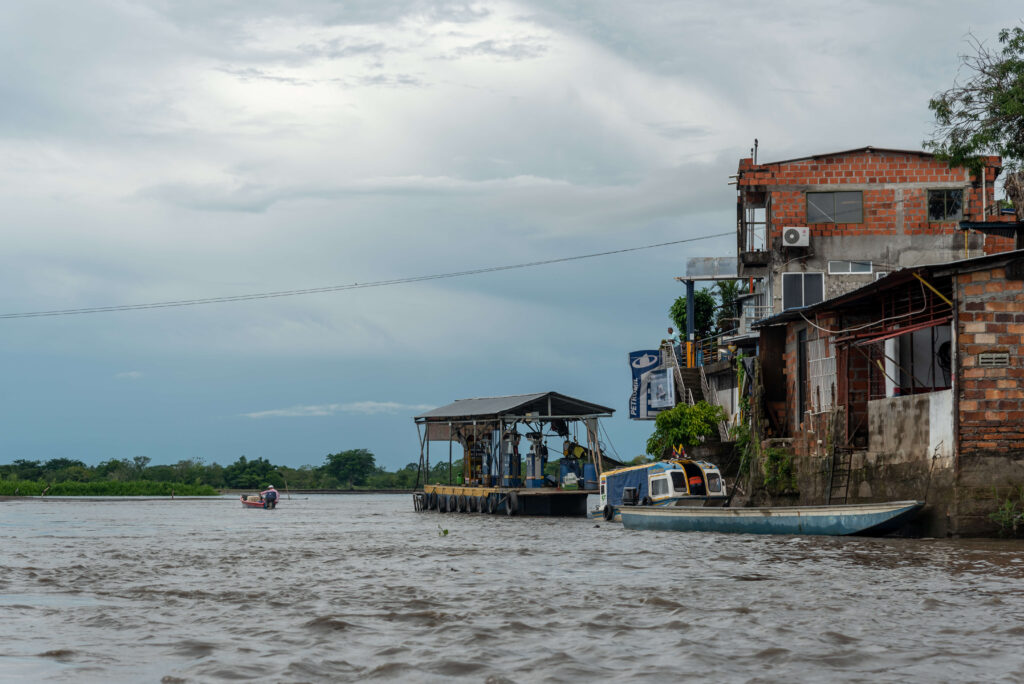
It was a scorching hot February afternoon in Sempegua village in Colombia’s Zapatosa Marsh. Merciless rays of sunshine beat down as temperatures soared to 100 degrees Fahrenheit (38 degrees Celsius). Tired, skinny cows with ribs and hipbones jutting out foraged the dry pastures in search of feed. A group of cattle ranchers took a respite from the sweltering heat and sipped juice made from uvita de playa, a local Caribbean fruit, under the shade of a tree while recounting the good times when there was plenty for everyone. “Things are much worse than what they were 30 years ago. The government does not care. We are barely surviving, and on some days, we have no hope. All we have is the community for support,” said a cattle rancher.
A group of cattle ranchers took a respite from the sweltering heat and sipped juice made from uvita de playa under the shade of a tree while recounting the good times when there was plenty for everyone.
The men and women from the villages of Sempegua and La Mata in the Magdalena floodplains of Colombia — home to 32.5 million people — shared their experiences with me during a visit earlier this year. The Center for Financial Inclusion (CFI), along with The Nature Conservancy and Accion, visited the Magdalena floodplains to understand how financial services can help community members manage the impact of climate change. CFI’s Green Inclusive Finance research team is working with climate NGOs and financial service providers in Colombia to uncover evidence and test promising solutions that help communities in the Magdalena floodplains develop resilience and adapt to climate change.
Livelihoods in this region are precarious, and the villages are wracked by climate shocks all year round. Summers are dry with long heat spells. Water levels recede, and there are fewer fish, a primary source of food. Community members must rise earlier and venture deeper into the wetlands to fish. The pastures become dry, leaving very little for cattle to forage on, and many ranchers are forced to sell their animals to survive. And when it rains, the Magdalena River overflows and inundates the villages, causing enormous damage to life, livestock, and livelihoods. The devastating floods caused by La Niña in 2010 and 2011, impacting over 2.2 million households, are a case in point. According to USAID estimates, in the years between 2000 and 2016, Colombia experienced at least 56 climate-related disasters, including devastating floods.
Diversifying Livelihoods
Given the fragility of the traditional occupations of fishing and cattle ranching, community members have had to diversify their livelihoods by collecting local fruits, managing nurseries and community gardens, and selling local snacks and alcohol. Nearly everyone we spoke to was engaged in fishing, but it was no longer the preferred livelihood choice, given the rising expenses and the risk of being attacked by stingrays or crocodiles. Cattle ranching, the other traditional occupation, was also becoming more unpredictable. Ranchers mentioned having to sell livestock, challenges finding fertile lands for grazing, and conflict with an industrial farming operation, which was increasingly encroaching on the grounds where the cattle grazed.
But these means of supplementing their livelihoods are proving equally precarious. The forest where the fruits grow is replete with venomous snakes. Furthermore, the industrial farming operation owns much of the land, and the women picking fruits have no choice but to trespass. Despite the hardships, community members said they prefer living in the village where they can lean on one another for support. “Finding a well-paying job in cities is hard,” explained a man who had recently moved back from the city of Barranquilla. “We need land to do some productive activity, earn money, and pay off our debts.”
Several people said they have access to bank accounts but rarely use them beyond accessing conditional cash transfers via the government-run Familias en Accion program. The few salaried people used their accounts to receive their pay. We probed deeper to understand why existing financial systems do not work for the vulnerable and what needs to be changed.
Our discussions revealed three key areas where appropriately designed financial services could help:
1. Financial Services Must be Tailored to Needs
Several people we spoke with had taken loans from banks and microfinance institutions. However, the experience was often stressful. The loans had high interest rates, and when crops failed because of climate change, banks rarely provided flexibility on the loan terms. This rigidity made it difficult for farmers to meet their loan obligations, and they reported needing to leave their children behind in the village to work in the cities so they could repay their debts. According to them, financial institutions did not understand their predicament or provide any support to reduce the pressure. Consequently, many preferred the convenience and flexibility local moneylenders (gota gotas) offered, even though they were more dangerous and expensive. The gota gotas visited the villages daily and were willing to adjust the repayment schedule when customers with good repayment records faced challenges.
While community members desperately need financial services that allow them to save safely, conduct transactions, and access credit for their livelihoods, existing offerings do not meet their specific needs.
Despite their small and unpredictable incomes, community members said they dream of rebuilding or renovating their houses or sending their children to college, and they try saving whenever possible. However, most people prefer storing their money at home, despite the risks of floods or termite infestations that have destroyed their savings. Some women expressed a desire to learn more about saving in a more disciplined manner, and a community-based organization and partner of TNC called Fundacion Alma responded by helping these women form their own savings group.
While community members were familiar with mobile money, not everyone owned mobile phones, and household members often shared phones. Even when they had phones, remembering passwords was a challenge. Furthermore, they frequently changed SIM cards to take advantage of promotions and offers from mobile companies, which required them to open new mobile money accounts. When they needed to withdraw or send money, they would travel to the nearest town and rely on an agent – who required a fee — to facilitate transactions.
These anecdotes illustrate that while community members desperately need financial services that allow them to save safely, conduct transactions, and access credit for their livelihoods, existing offerings do not meet their specific needs.
Financial services could help residents of the Zapatosa Marsh transition to more climate-resilient livelihoods if the financial service providers were to adapt their offerings to better meet the needs and vulnerabilities of the communities, as CFI has outlined in its Green Inclusive Finance taxonomy. The taxonomy lays out the various impact pathways through which financial services can help: mitigation, resilience, adaptation, and transition.
2. Financial Services and Skills-Building Can Multiply Impact
Even when community members had access to financial services, they had a minimal understanding of the features and terms associated with a product. For example, one woman mistakenly assumed that the credit life insurance covering her loan in the event of death would also cover loan defaults. Consequently, she was very disappointed when it did not help cover late payments related to the credit she used to buy her boat.
Most community members were skeptical about the utility of financial capability-building programs and felt these initiatives would have limited relevance given their volatile incomes. One exception was a salaried teacher who mentioned attending a financial education program offered by a bank that helped him learn how to budget and save money. However, community members were eager to participate in training that would equip them with skills to provide value-added services, such as making fruit juice or wine and accessing new markets.
While most people were familiar with WhatsApp and Facebook, they remained cautious about digital apps and preferred in-person programs where they would have opportunities to ask questions. By offering digital and financial education and supporting community members to start small businesses and access markets, there is a more significant opportunity to strengthen resilience and improve livelihood outcomes.
3. Consumer Protection is a Priority
“My husband and I took a home improvement loan. Since our earnings from fishing and collecting uvita de playa were insufficient, I moved to Valledupar and worked as a maid for a year to pay off the loan. But even after all our efforts, the loan still appears as red [unpaid] on the [credit] bureau,” explained one woman. Another person reported having a credit bureau record for a loan he never applied for or received. Others reported instances where they had to pay additional installments or fees or were victims of identity theft.
When asked about available recourse channels, most community members said it cost them too much time and money to travel to the bank in the city to sort out these problems, so they left them unresolved. Instead, they relied on gota gotas when they needed credit.
As weather patterns change, consumers face risks from newer sources that impact their financial lives at any stage of their interaction with financial services. Consumer protection is integral to building customer trust and is a cornerstone of a stable financial system.
Systemic changes are needed for financial services to support low-income, vulnerable communities in preparing for, responding to, and recovering from climate shocks while protecting them from additional harm.
Our visit to the Zapatosa Marsh exemplifies the area’s high vulnerability to climate change, which is already forcing the community to seek new livelihoods. These changes will only become more acute. Droughts and extreme floods in the region are expected to intensify. Entire villages risk being eliminated should there be another El Niño, which weather forecasters predict this year. With annual temperatures projected to rise by 1-1.5 degrees and precipitation to increase by 5-15% by 2040, the climate crisis is becoming increasingly real and urgent. Systemic changes are needed to enable the financial services sector to support low-income, vulnerable communities in preparing for, responding to, and recovering from climate shocks while protecting them from additional harm.
Acknowledging the urgent requirement for contextually relevant and responsible financial services in communities like the Zapatosa Marsh is vital. This situation provides a significant opportunity for organizations specializing in climate and inclusive finance to collaborate, acquire evidence, and test solutions to safeguard vulnerable communities from unintended adverse effects.










